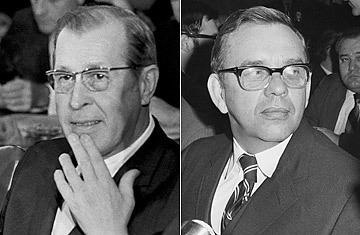Allegiance United States Political party Democratic Party | Preceded by Armistead Dobie Role Judge Appointed by Dwight Eisenhower Name Clement Haynsworth Battles and wars World War II | |
 | ||
Full Name Clement Furman Haynsworth, Jr. Alma mater Furman UniversityHarvard University Similar People Earl Warren, John Marshall Harlan II, William J Brennan - Jr, Ronald Davies, Charles Evans Whittaker | ||
Clement Furman Haynsworth Jr. (October 30, 1912 – November 22, 1989), was a United States judge and an unsuccessful nominee for the United States Supreme Court.
Contents
Background
Haynsworth was born in Greenville in northwestern South Carolina. He received a Bachelor of Arts from Furman University in 1933 and an LL.B. from Harvard Law School in 1936. He was in private practice of law in Greenville from 1936 to 1957, aside from his years of service in the United States Navy from 1942 to 1945 during World War II.
Judicial career
Haynsworth was a federal judge on the United States Court of Appeals for the Fourth Circuit, being nominated by U.S. President Dwight D. Eisenhower on February 19, 1957, to a seat vacated by Armistead Mason Dobie. Haynsworth was confirmed by the United States Senate on April 4, 1957, and received his commission the same day. He became chief judge in 1964.
On August 21, 1969, President Richard M. Nixon nominated Haynsworth to be an Associate Justice on the U.S. Supreme Court. He was proposed to succeed liberal justice Abe Fortas, who had resigned over conflict of interest charges. Haynsworth was opposed by a coalition of Democrats (possibly in retaliation for the Republicans' rejection of Fortas as Chief Justice), Rockefeller Republicans, and the NAACP. He was alleged to have made court decisions favoring segregation and of being reflexively anti-labor. Democratic U.S. Senator Philip Hart of Michigan said that Haynsworth's decisions on civil rights and labor management were "unacceptable," while Republican Senator Marlow Cook of Kentucky argued that Haynsworth was being "subjected to a character assassination that is unjustified." Cook argued that Haynsworth was "a man of honesty and a man of integrity."
Haynsworth was also accused of ruling in cases in which he had a financial interest, although this claim was never proved. Haynsworth was later termed a "moderate" who was "close in outlook" to John Paul Stevens, a 1975 nominee of President Gerald R. Ford, Jr.
Haynsworth's nomination was defeated by a vote of 55 to 45 on November 21, 1969. 19 Democrats and 26 Republicans voted for Haynsworth while 38 Democrats and 17 Republicans voted against the nomination. Haynsworth was the first Supreme Court nominee to be defeated by the Senate since the rejection of Judge John J. Parker (also of the Fourth Circuit) in 1930. Nixon eventually nominated Harry Blackmun, who was confirmed by the Senate.
The rejection of Haynsworth became an issue in the 1970 race for governor of South Carolina. James B. Edwards, an oral surgeon from Charleston, who was then the Republican chairman of South Carolina's 1st congressional district, claimed that the Democratic candidate, John C. West, the outgoing lieutenant governor, had opposed Haynsworth's confirmation, a claim that West denied. Edwards claimed that the election of West over the Republican nominee, U.S. Representative Albert Watson of South Carolina's 2nd congressional district, a Haynsworth supporter, would mean an "ultra-liberal, minority-dominated state government." Democrats accused Edwards of "twisting the truth almost beyond belief." West defeated Watson, but in 1974 Edwards was himself narrowly elected as the first Republican governor of South Carolina since Reconstruction. At the time governors of South Carolina could not succeed themselves. Edwards was also the first United States Secretary of Energy in the Ronald W. Reagan administration.
After his defeat, Haynsworth remained on the Fourth Circuit in Greenville. He assumed senior status on April 6, 1981, which he retained until his death in Greenville on November 22, 1989. The C.F. Haynsworth Federal Building and United States Courthouse in Greenville was renamed in his honor.
